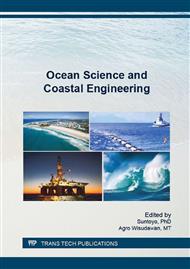p.3
p.9
p.16
p.21
p.27
p.34
p.41
p.46
Turbulent Mixing in Raja Ampat Sea
Abstract:
Raja Ampat Sea has a complex geometry and passed by Indonesian Throughflow (ITF) causing a very dynamic water condition, that condition also amplified by turbulent mixing. To gain better understanding of process and extent of turbulent mixing in Raja Ampat Sea, this research calculate Brunt-Vaisala frequency, Richardson number, turbulent kinetic energy dissipation rate and vertical diffusivity coefficient. The data obtained from Expedition Widya Nusantara (EWIN) by P2O-LIPI in the territorial of Raja Ampat Sea on 14-24 November 2007, by using 12 out of 33 observation stations. From this research, it is known that in 0-40 m (mixed layer) and 250-400 m (deep layer) have Richardson number (Ri) less than 0.25 and high vertical diffusivity coefficient (Kv), It proves a strong turbulent mixing occurs at those depth. Furthermore, Raja Ampat Sea has strong turbulent mixing with average value of turbulent kinetic energy is 2.64 WKg-1and vertical diffusivity coefficient is 1.65x10-3 m2s.
Info:
Periodical:
Pages:
9-15
Citation:
Online since:
January 2017
Price:
Сopyright:
© 2017 Trans Tech Publications Ltd. All Rights Reserved
Share:
Citation:


